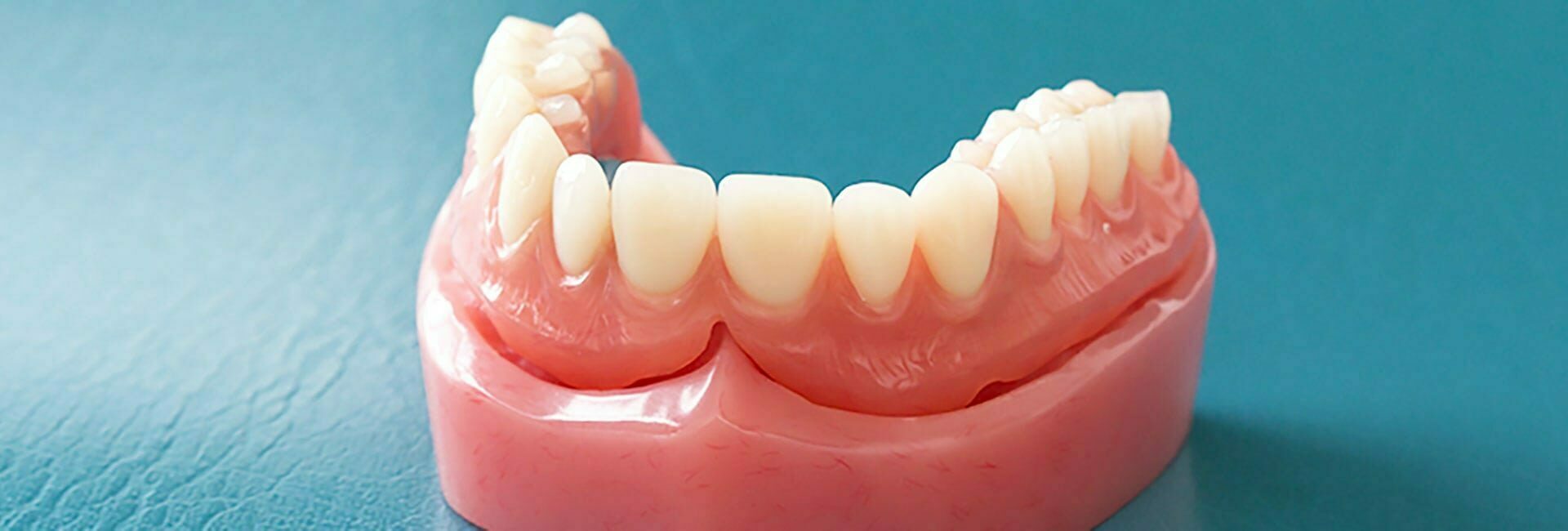
Implant-supported prostheses
Due to the action of tooth decay (caries) and particularly as a consequence of inflammation of the gums (periodontal disease), it can happen that not a single tooth can be preserved any longer, i.e. patients experience complete tooth loss. These patients experience a far more extreme deterioration of quality of life: they can no longer give a relaxed smile; enjoying chewing food, and being able to do so effectively with your own teeth can turn into a pipe dream. In these cases, a complete denture is usually made.
Unfortunately, only in rare cases is it possible to achieve a good fit for the denture in the upper jaw of the mouth. This makes chewing a real ordeal, as the loose-fitting prosthesis damages the gums… Pains and pressure points become a daily torment. This solution also leaves a lot to be desired in terms of creating confidence. Even the use of adhesive creams cannot significantly improve the situation.

Here once again, the saviour comes in the form of treatments using dental implants: with just a few implants, an existing prosthesis can be fixed into the mouth, holding firm during talking and chewing… A new lease of life! An existing prosthesis can be easily and reliably attached to implants that are anchored into the jaw bone. This is achieved using a clip-style mechanism (locator and ball anchor). With a clear click as the prosthesis is fixed into place, you can say goodbye to any worries about the prosthesis moving around or falling out of place.
Our dentists can combine either existing prosthesis or new prosthesis using the click-in fastener, both in the upper and the lower jaw. It makes sense to manufacture a new prosthesis in cases where extensive modifications would have to be made to an existing prosthesis due to a poor fit. The new prosthesis is also protected against breaking with metal reinforcements. These metal reinforcements are fixed onto the implant heads by our dental technicians using a click-in fastener. This method produces a very durable final solution that allows for solid chewing. Generally, two titanium implants set into the jaw bone are required per jaw. These can later be fitted with the prosthesis after an approx. 8-week healing period.
During our initial consultation, we establish what the initial state of your teeth is, carry out an assessment regarding the availability of bone material, soft tissues, the remaining teeth in the upper and the lower jaw, and create a treatment plan suited to you.
If you then decide that you would like to go ahead with an implant-based prosthesis treatment, the subsequent consultations will be dedicated to inserting the necessary implants using a local anaesthetic.
After the healing process is completed, the new dental prosthesis can be clipped onto the now healed implants, and you can start enjoying a new-found ability to chew and speak with ease. It is important to remember that this prosthesis is never completely fixed into the jawbone, but rather should be taken out for cleaning after any meals, and then immediately put back into place. As such, this is a type of removable solution. The dental prosthesis is attached to the implants, but is also detachable, whilst still providing an anchor and good fit to stop any unwanted movement. Chewing is very effective and can be enjoyed once again, as a solid fit is achieved without any material covering the palate. This means that our patients can enjoy completely normal, unrestricted tactile and taste sensations when eating and drinking. The appearance achieved is also completely natural, as the implant-supported prosthesis is elaborated by our dental technicians to look as natural as possible. Distinguishing the prosthesis from normal teeth is all but impossible.

„The improvement in the bite situation is most impressive in treatments using implant-supported ceramic bridges: they boast a convincing appearance, effective chewing capabilities, and only a short familiarisation period, all of which delight our patients.“
Dr. Eva Krapf, Dentist at the Dr. Hager Dental Practice
For our patients who have no remaining teeth, the next step up in comfort can be achieved using a treatment based on fixed ceramic teeth that are anchored by implants that are inserted into the bone. These implant-supported ceramic bridges represent a complete restoration of both sets of teeth for patients that have no remaining teeth. It meets the highest of expectations in every respect: appearance, function and compatibility. The ceramic teeth have the same beautiful shimmer and visual appearance as natural tooth enamel. Our patients, dentists and dental technicians alike are always delighted with how the result looks.
Functionality is perfect too, though, so much so that after a certain familiarisation period, the anchoring to the dental implants can no longer be felt by patients. It is no wonder, then, that we are always delighted to point out this treatment as our gold standard. This treatment can offer outstanding performance only when combined, of course, with our surgical team, prosthetics dentists, dental technicians, and the rest of our extended team here at the dental practices. With our slick manufacturing process, we are able to recommend our patients this highly-successful treatment in cases where the oral situation we are faced with is particularly complicated.
Here is the procedure for this sophisticated treatment with fixed implant-supported dentures:
1. Detailed planning consultation with our experienced specialists considering all possible treatment options. Diagnostic documents obtained, with X-ray diagnostic imaging, photos taken, and thorough clinical examination. You will receive a clearly-explained and reliable cost quote, together with an exact treatment plan with timings for the entire treatment for you to take away to discuss with your family at home.
2. Once you have made your decision, the jaw for treatment with implants will be prepared: all inflammation, root remnants, and unsuitable and harmful tooth remnants are removed, so that healthy bone and gums can guarantee a reliable basis for the implant-supported crowns (our metal-free, all-ceramic crowns). Until the definitive denture is ready, a provisional prosthesis may be fitted, where required.
3. Our implantology specialists insert the implants as planned, generally during a surgical procedure. A bone-graft procedure is also usually required at this point. As the starting situation is inflammation-free, it is possible for us to provide pain-free surgery under local anaesthetic for the entire treatment. For a well-planned, surprise-free treatment, we can count on: availability of all the required instruments; diagnostic tests, including 3D X-ray technology; navigation-aid technologies; any required medicines; and last but not least, an experienced and friendly team!
4. After a healing period, normally around 8 weeks, our prosthetics dentists take over treatment, providing you with your new dentures. At this stage, too, there is a very highly-developed workflow being followed.
5. Now, our dental technicians set about manufacturing your all-ceramic bridges to meet the highest of technical and aesthetic demands. To achieve this, they use digital ceramic milling technologies, and their own all-important crafting skills, developed through years of experience. If desired, during our individual consultation with you we can discuss individual design preferences, such as tooth position, colour, shape etc. in the bridges. Feel free to bring along any old photos to show us what your teeth looked like in the past. Our dental technicians will be happy to have a discussion with you before creating your dentures: they enjoy meeting the patients who will be wearing the dentures that they create!
6. Even on fitting of the new, fixed dentures and crowns, some two weeks later, you should feel free to have a peek over the prosthetics dentists shoulder.
All of the treatments described are carried out under local anaesthetic. If you still have any worries, though, the treatment can also be carried out using nitrous oxide (laughing gas) if you prefer.
Can the fixed bridge treatments always be used, even in cases of extensive tooth loss?
Thank to advanced bone-grafting techniques, fixed bridge treatments can be provided even in the case of extreme bone loss, using implants to anchor the bridge in place. It is just the duration of the treatment that is longer as extra time is needed for new bone growth.
In my case, I still have some good teeth left. Would these need to be removed before treatment?
No, we are always happy to see healthy and solid teeth, which can then be incorporated into the treatment reconstruction. This is where the many years of experience of our specialists becomes particularly beneficial: they can assess you for the most advantageous and sustainable long-term solution in your individual case. Every case is different, of course, making general comparisons and speculation of what treatments plans might involve somewhat unhelpful.
What is better: a removable or a fixed solution?
Depending on patient wishes and particular issues, the treatment type, how extensive the surgical procedure required is, and also the treatment costs are all important factors to consider when choosing the best treatment option for you. The best advantages, however, are offered by the fixed-bridge treatments based on implant supports.
Will I be able to eat and talk normally again?
Yes! After a certain period of adaptation and familiarisation, you will not be able to perceive the difference between normal teeth and the implant-supported prosthesis or bridges.
Will people be able to see that I have had a treatment with dental implants? Will the result look good?
Due to the committed work and perfected skills of all of the members of our team, we are able to achieve a good aesthetic result even in the most difficult cases. All-ceramic crowns, digital support during surgery, and exceptional manual skills all improve the effectiveness of the implant-supported prostheses and bridges, fixed and removable alike. By having the dental laboratory in close proximity to the dentists’ treatment rooms, a particularly individualised design can be achieved with the best aesthetic result.
How often will I need to come to the practice for this kind of treatment?
Generally, patients can go away with a definitive treatment after around 4 appointments in the case of more intensive treatments with implants and bone grafting (in cases of severe damage to the jaw bone). This applies to both removable dentures and fixed, implant-supported prostheses.